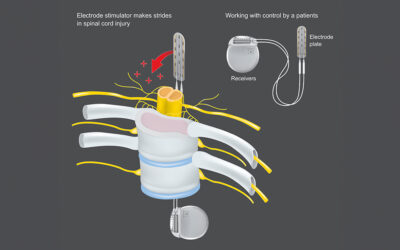Does your back stiffen up and ache frequently? It could be due to back spasms. Learn what they are and how to treat them.
Back pain is one of the most common orthopedic complaints among adults in the U.S. In fact, the Centers for Disease Control and Prevention found that around a quarter of adults reported lower back pain in the past three months alone. Much of that discomfort is likely caused by back spasms.
Back spasms are involuntary contractions of the back muscles. The spasms can feel like anything from a minor ache to a sudden, sharp pain or a tightening of the muscles so severe it prevents movement. Your back muscles may spasm after an acute strain, such as lifting a heavy object, or after twisting your back in an unusual way — as you might while playing a sport like golf or football. Certain underlying orthopedic conditions including arthritis, spinal stenosis (a narrowing of the spinal canal), or a herniated disc can also cause back spasms.
Fortunately, muscle spasms rarely need to be treated with surgery. Instead, the discomfort usually resolves on its own with the help of some conservative treatments.
How to Treat Back Spasms
If you experience a back spasm, it’s best to see a doctor. The doctor will begin by asking you when the pain began to determine what may have caused it. If the pain started after you moved some heavy objects, for example, your doctor will likely diagnose the spasm as resulting from a muscle injury. Knowing what caused the spasm can help you prevent others from happening in the future. If your doctor deems it necessary, they may also order imaging tests to see if there are any broken bones or arthritis that might have contributed to the muscle spasm.
Once your doctor determines what caused the spasm, they can suggest some at-home treatments suited to your condition. Treatment typically relies on reducing the pain associated with the back spasm and getting the muscles to relax. Common treatments include:
- Rest. Working out or attempting to carry out your normal activities following a back spasm will only strain your back muscles further. Take a day off from work and give your back some time to recover. If you must exercise, take a short walk. Walking speeds blood flow to the back, which promotes healing. Make sure that when you do walk, you stroll along an even path. Avoid uphill or downhill tracks that may aggravate your back pain.
- Hot & Cold Therapy. An alternating program of hot and cold therapy can alleviate your back pain and unlock tense muscles. To reduce inflammation, apply a cold compress to the back. To loosen tight muscles, apply heat, which will rush healing blood to the area. To avoid damaging your skin, make sure never to leave the hot or cold pads on for more than 15 minutes at a time.
- Medications. Back pain can be treated with over-the-counter nonsteroidal anti-inflammatory medications like ibuprofen, naproxen, and aspirin. Acetaminophen is not included in this list because while it can reduce pain, it won’t address inflammation. If your pain is severe, your doctor may prescribe muscle relaxants — but relaxants should only be used for a short period of time and you should be aware that they can cause side effects such as dizziness. If you need a more intensive intervention, another option is a trigger point injection into the knot of tight muscles. No matter which option you pursue, always consult with your doctor before taking any medication (including an over-the-counter drug) to ensure it doesn’t interfere with other medications you may be taking.
- Physical Therapy. You may not realize it, but weak abdominal muscles can contribute to back spasms. A physical therapist can model exercises to strengthen the back and abdominal muscles and prevent future spasms — but remember: you should only attempt these exercises yourself when the back spasms have passed and the muscles can endure strenuous activity. In addition to guided physical therapy, pay attention to your posture throughout the day. When you sleep, make sure your upper body is at a slight incline with a pillow propping up your knees. When you’re relaxing during the day, try to sit in a recliner with your body at a slight incline with your knees bent and your legs supported. If you’re working at your desk, avoid slouching as much as possible.
- Some Final Tips: To maintain the health and stability of your back, avoid staying in one position for too long. Back spasms are frequently the result of spending too much time in an awkward position. Also, remember to stretch and warm up your muscles before exercising. Cold muscles can stiffen from sudden movement and injure more easily. Make sure you also stretch after your workout to prevent your muscles from tightening. And be careful to always stay hydrated, whether you’re exercising or not. Your muscles need water to stay limber and keep from spasming.
Why Suffer From Back Pain?
If you experience back spasms or other back pain, there’s no reason for you to keep suffering. The physicians at Comprehensive Orthopaedics have helped many patients overcome persistent back pain. We’ll create a tailored treatment plan that will reduce your discomfort and help you feel your best, so you can enjoy your daily activities once again. Contact us today for a consultation.



